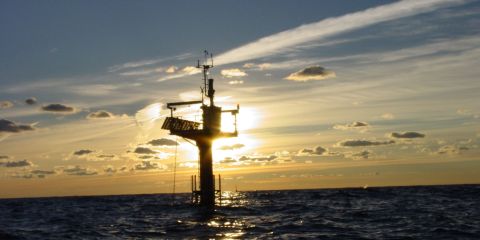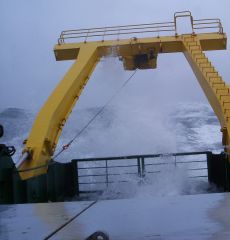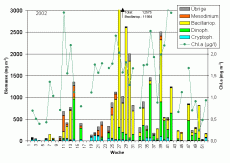

Phytoplankton development at the coastal station "Seebrücke Heiligendamm" in 2002
The results of the weekly sampling at the sea-bridge Heiligendamm (54°08,55' N; 11°50,60' E, 300 m off shore, 3 m water depth), performed by the Baltic Sea Research Institute Warnemünde (IOW) are shown in Fig. 1. The line shows the chlorophyll a concentration and the columns the phytoplankton wet weight. Columns are lacking on particular sampling dates if quantitative microscopical counting was not possible due to high content of resuspended sediments in the samples owing to strong wind. Respective chlorophyll data are sometimes unreliable and therefore also not shown.
Until 5.2.2002, the cryptophycee Teleaulax sp. was the dominant species, while the sub-dominant photo-autotrophic ciliate Mesodinium rubrum decreased. On 19.2. (8. week), the diatom Thalassiosira anguste-lineata developed to a wet weight of 22.6 mg m-3 (total chl.a = 1.4 mg m-3). On 5.3.2002, the flagellate Eutreptiella sp. and the ciliate Mesodinium rubrum dominated. After a further strong growth of Mesodinim rubrum by the 11.3.2002 (11. week), the diatom spring bloom developed to a peak chl.a concentration of 3.0 mg m-3. It was mainly composed of Chaetoceros species (e.g. Ch. diadema, Ch. debilis, Ch. curvisetus), Rhizosolenia setigera and Thalassiosira anguste-lineata. Also the silico-flagellate Dictyocha speculum (here counted as "others") was important. The mentioned species decreased by the 19.3. and were replaced by the typical late-bloom diatom Skeletonema costatum, which increased to 641 mg m-3 by the 26.3.02 (week 13). The diatom bloom disappeared abruptly by the 9.4.2002. A mass growth of an unidentified athecate dinoflagellate (40-50 µm length, perhaps Gymnodinium cf. lohmannii) followed. This change of population was accompanied by a development of Mesodinium rubrum. At the end of April, all species decreased.
The post-bloom phase was dominated by cryptophyceae (Teleaulax sp., Hemiselmis sp.). After a short pulse of Mesodinium rubrum (week 22) and Heterocapsa rotundata (week 24), the typical summer bloom of the large diatom species Dactyliosolen fragilissimus starts. The maximum of this species was reached on 10.7.2002 (27. week) with a wet weight of 11801 mg m-3. The high biomass is not reflected in the chlorophyll concentration because the biomass of the large diatoms is mainly based on a large vacuole that does not contain chlorophyll. On 30.7., also Cerataulina pelagica was important (394 mg m-3). A cyanobacteria bloom did not occur.
On 27.8.02 (34. week), the last pulse of Dactyliosolen fragilissimus (382 mg m-3) was noticed. The dinoflagellates Ceratium tripos and Prorocentrum minimum developed. The autumn bloom of dinoflagellates started as early as 10.9.02 (36. week), with Ceratium tripos (902 mg m-3) und C. fusus (180 mg m-3). They disappeared already in the following week due to currents that transported the diatom Coscinodiscus granii (24.9.02: 164 mg m-3) to the sampling station. The biomass peak of the bloom was noticed on 1.10.02 (39. week), composed mainly of Coscinodiscus granii (1323 mg m-3) und Ceratium tripos (634 mg m-3). After a storm, these species disappeared almost completely for the benefit of Cerataulina pelagica (44. and 45. week). Quick changes in dominance of Ceratium tripos, C. fusus, Thalassiosira anguste-lineata and Actinocyclus sp. occurred in the following weeks due to hydrographical instabilities.
The three big blooms are roughly reflected in the chlorophyll a concentrations which exceeded 1,5 - 2 mg m-3 during bloom situations. Therefore, the spring bloom lasted from week 11 to 13 (14), the summer bloom from week 25 to 31, and the autumn bloom from week 34 to 42 (with interruptions).
IOW, 10.03.2004
Dr. Norbert Wasmund,
Susanne Busch,
Ina-Marie Topp,
Regina Hansen.

State of the Baltic Sea
- Annual Reports on the state of the Baltic Sea Environment
- Cruise Reports
- Data from the autonomous measuring stations
- Development of the suboxic and anoxic regions since 1969
- Baltic Thalweg transect since 2014
- Algal blooms at Heiligendamm since 1998
- "Major Baltic Inflow" December 2014
- "Major Baltic Inflow" January 2003
- Baltic saline barotropic inflows 1887 - 2018
- Further Reading

